Introduction
This piece is a website that I created for COMSTRAT 701: Master’s Independent Capstone Project in Fall 2024. My instructor was Rebecca Cooney.
COMSTRAT 701 is the final course in the Strategic Communication online MA program and designed to be a culmination of all that you have learned in the previous nine courses. Capstone deliverables are a demonstration of the student’s mastery of core MA concepts through a “comprehensive exam” and professional online portfolio. Students are assessed in three core attributes: critical thinking, written communication, and creativity. The “comprehensive exam” is not an exam at all. It is project-based and includes a series of prompts for students to respond to questions, case studies, or activities. Each response is open-book (not proctored) and completed individually (non-collaborative). With these prompts, students are asked to demonstrate their understanding and proficiency in the following core areas:
|
|
Project Background
This website tells the story of Emil and Emilie Gabelein, my ancestors who immigrated to the United States in 1890 from the Saxony (Sachsen) region of Germany. This is the story of my family’s roots and knowing where my paternal line originated is incredibly special.
For many years, the identities of Emil and Emilie’s parents and ancestors were a mystery, minus a few clues we had from oral histories, baptism records and death certificates. These were all found in American documents, and we had been unable to break down the brick wall in our research to find verifiable German records.
Earlier this year (2024), I was able to use DNA testing and information provided by a distant relative in Germany to locate church records which include Emil’s birth and baptism records. These included the names, birth, marriage and death dates for his parents and grandparents, as well as specific towns where they lived!
Sharing the stories of my ancestors is something I am very passionate about. Many of my family members have been trying to break down these genealogy brick walls for years. I am excited to be able to document our history for them, as well as future generations. I want my family to know and cherish the story of Emil and Emilie’s determination, sacrifice and perseverance. To find a better life for their children that was free of poverty and religious persecution, they crossed an ocean and lived in three states before finding their forever home.
Design Process
I chose to create my scrollable one-page website in Canva, because I have a paid subscription which includes the use of stock photos. I use the tool daily daily for work and personal projects, so it was the logical choice. For the sake of time and convenience, I selected one of Canva’s basic website templates as a starting point.

The first frame includes images of Emil and Emilie and the site name: “Our German Roots.” Beneath the name was a subtitle in green: “The Story of Emil and Emilie Gabelein.” The images are wedding portraits taken in either 1881 or 1882 (depending on whether you choose to believe census records, death certificates or Gabelein family lore). For the background, I used a stock photo of Germany’s Black Forest.
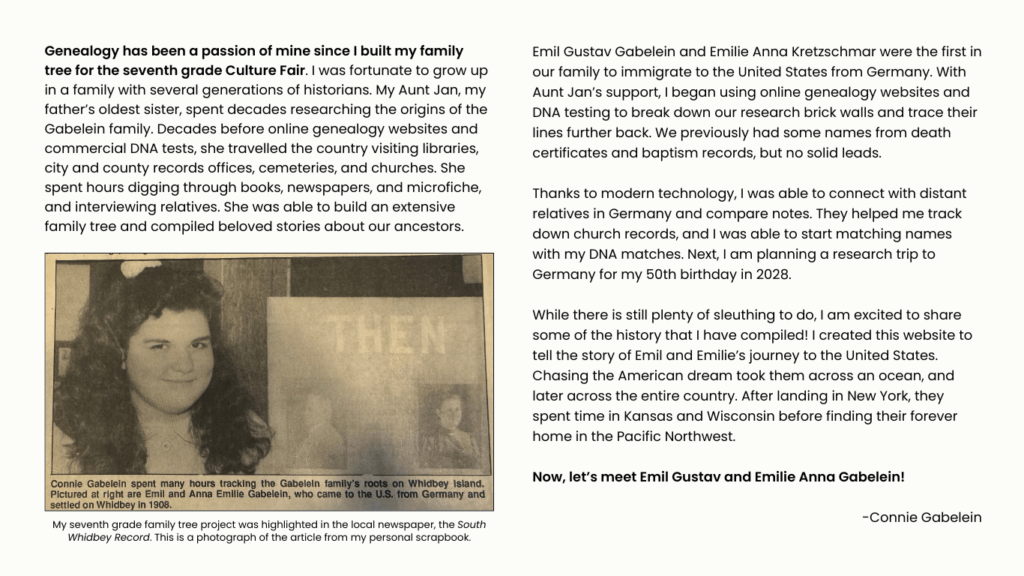
Next, I included some background about my love of genealogy which blossomed when I researched my family tree for the 7th Grade Cultural Fair. I added a photo of a South Whidbey Record newspaper article about the event, in which I was pictured with my project display. I thought the clipping would help bring context and personalize the story, especially since the same images from the title page are shown.
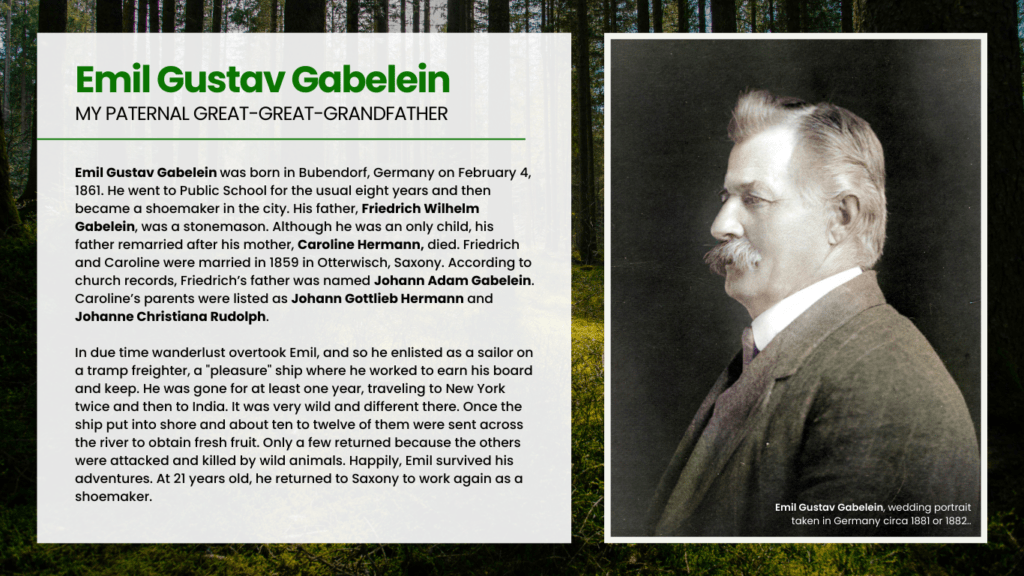
The image of Emil is shown again in the next frame, with his full name, Emil Gustav Gabelein, and our relationship. He was my paternal great-great-grandfather. I included a few paragraphs about his life, starting with his birth in Bubendorf in 1861 and ending when he was 21 years old and returning home after traveling abroad on ships to India and New York.
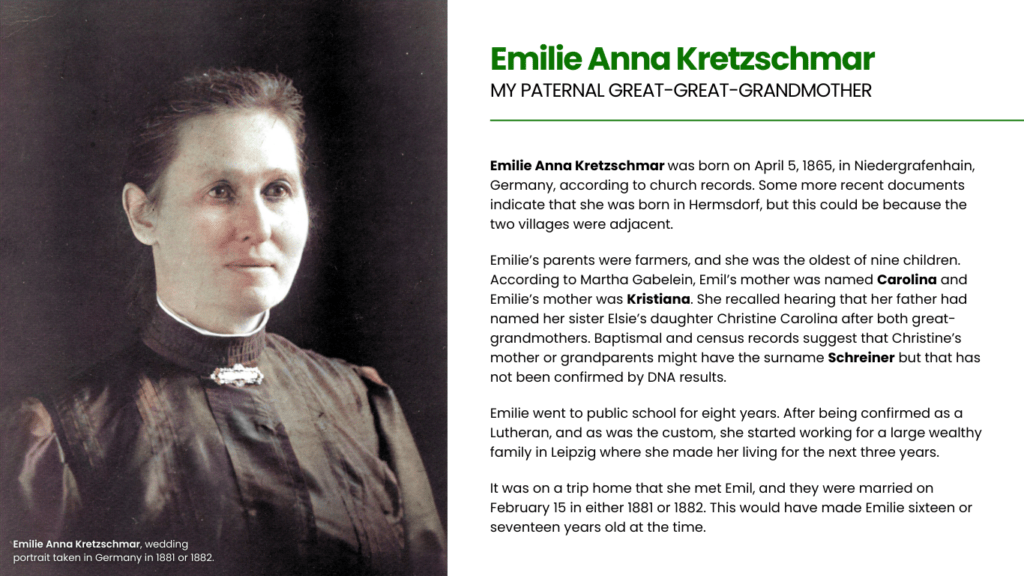
Next, I created a similar page for Emilie with her full name: Emilie Anna Kretzschmar, and our relationship. She was my paternal great-great-grandmother. Emilie’s story began in Niedergrafenhain, Germany, where she was born in 1865. This page ends by explaining how Emil and Emilie met and married in 1881/1882.
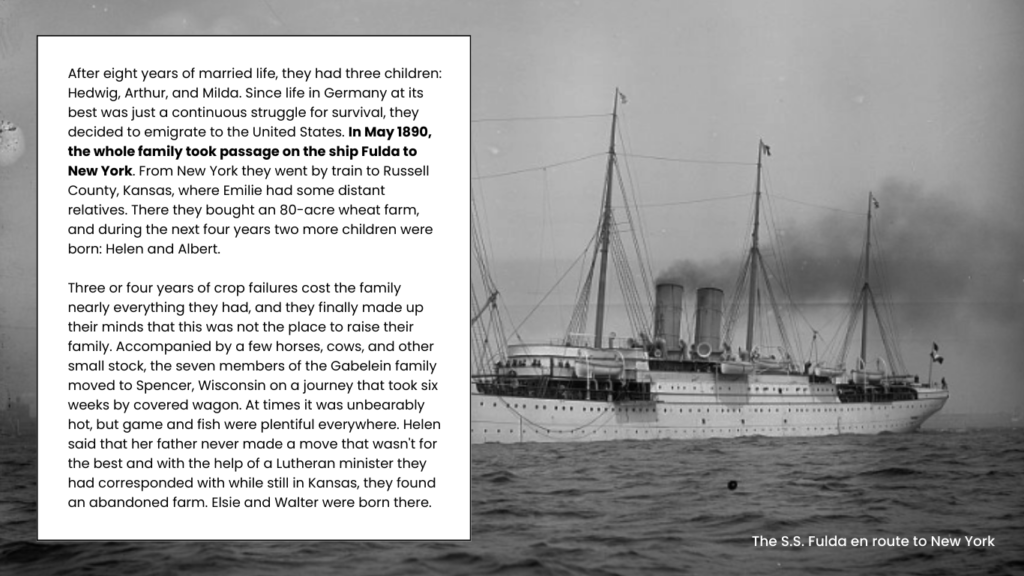
On the fifth frame, I shared the story of Emil and Emilie’s journey from Germany to the United States. Since the name of the ship that brought them here was listed on official immigration records, I used a Library of Congress photograph of the S.S. Fulda as the background.
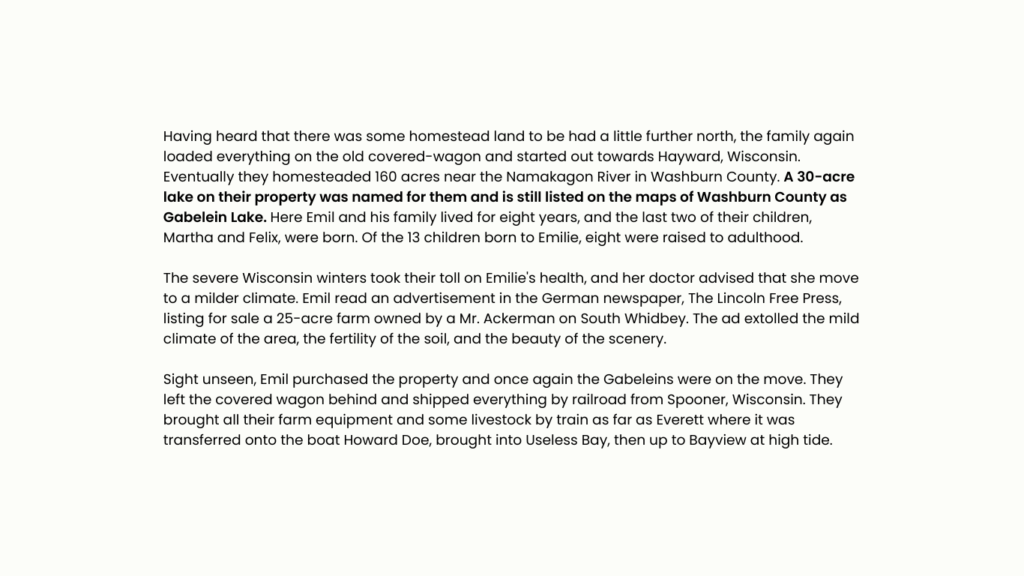
I embraced white space on the next frame, including only simple black text to tell the story of their moves from Kansas to Wisconsin, and Wisconsin to Washington State. As you can see, I am a fan of alternating between light-colored backgrounds and image or dark-colored backgrounds from one frame to the next.

Next, I described the family’s new home on Whidbey Island, which was less than a mile from the farm where I grew up. I again used the image of the Black Forest as a background, and included a stock photograph of a Whidbey Island beach. Whidbey’s forests reminded the family of their home in Germany, so it seemed appropriate.
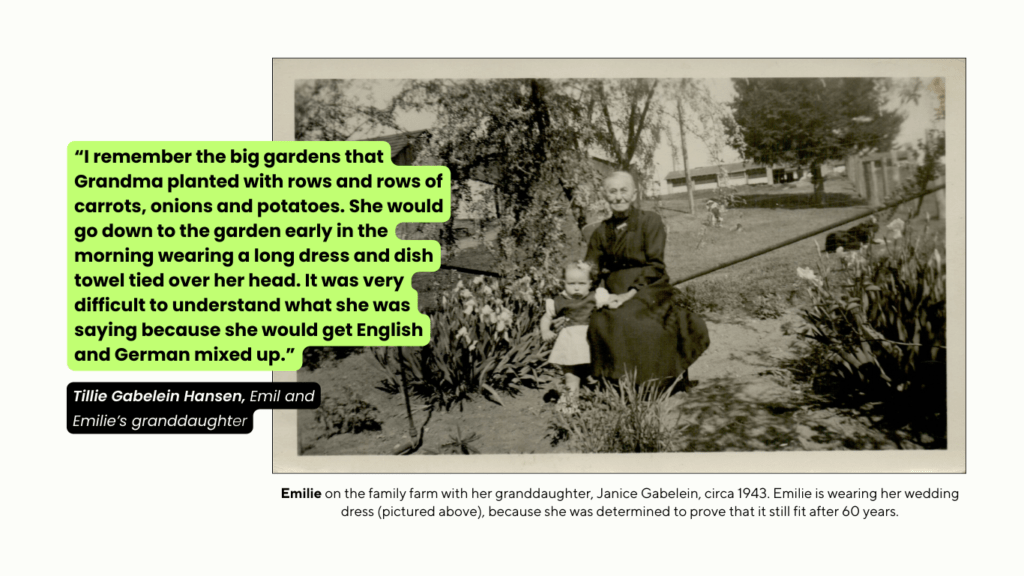
I featured a quote from one of Emil and Emilie’s granddaughters, taken form one of the oral histories that were documented by family members. It accompanies a great photograph of Emilie, late in life. She is pictured in her garden with my Aunt Jan, who spent decades researching our genealogy. Emilie is wearing her wedding dress in the image, because she wanted to prove that she could still fit into it after 60 years. Priceless!
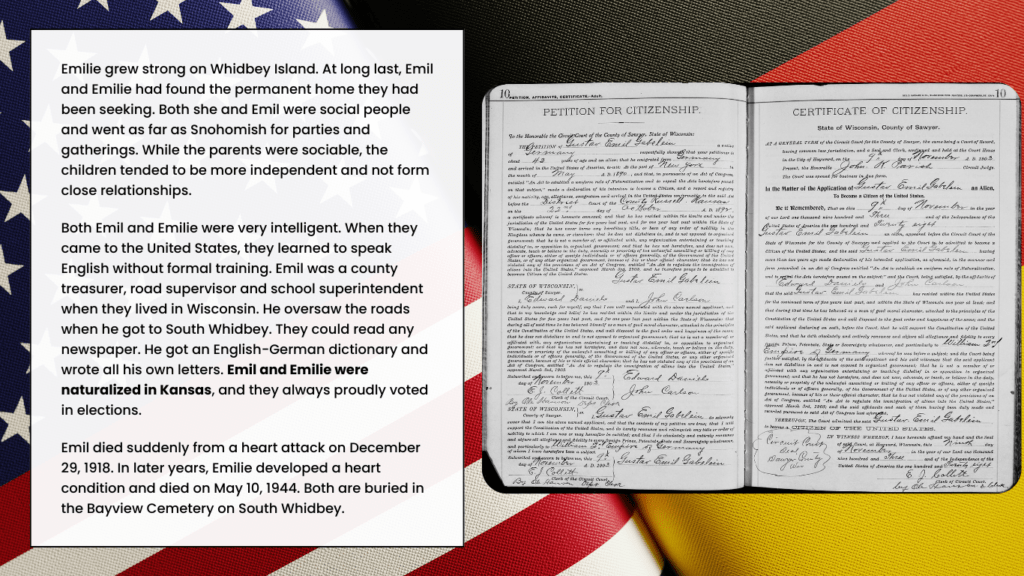
The next frame shares more about Emil and Emilie’s lives on Whidbey Island. After years of struggling and moves across oceans, and multiple states, they ultimately found their happy ending and forever home. I used a stock photograph of the United States and Germany flags as the background. Also pictured is a scanned copy of Emil’s application for citizenship.
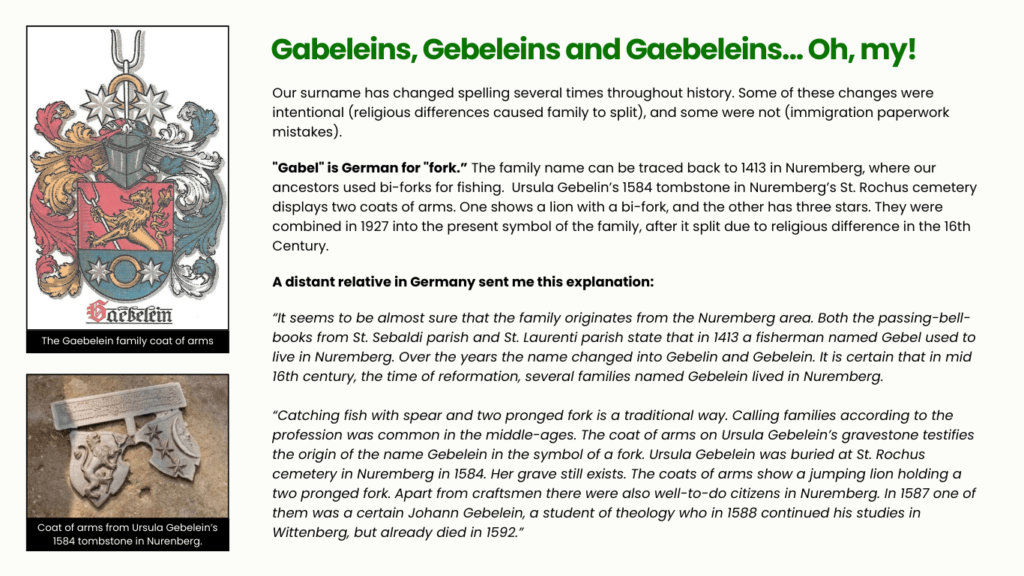
It was important to me to share information about the origins of the Gabelein name and our family coat-of-arms. Our relatives use several different spellings based on their location and branch of the family. Gabelein, Gebelein and Gaebelein are the most common, but I also see Gebel, Gabeline, or other variations in my research. The images and quotes in this frame were provided by a distant relative who I found in Germany.
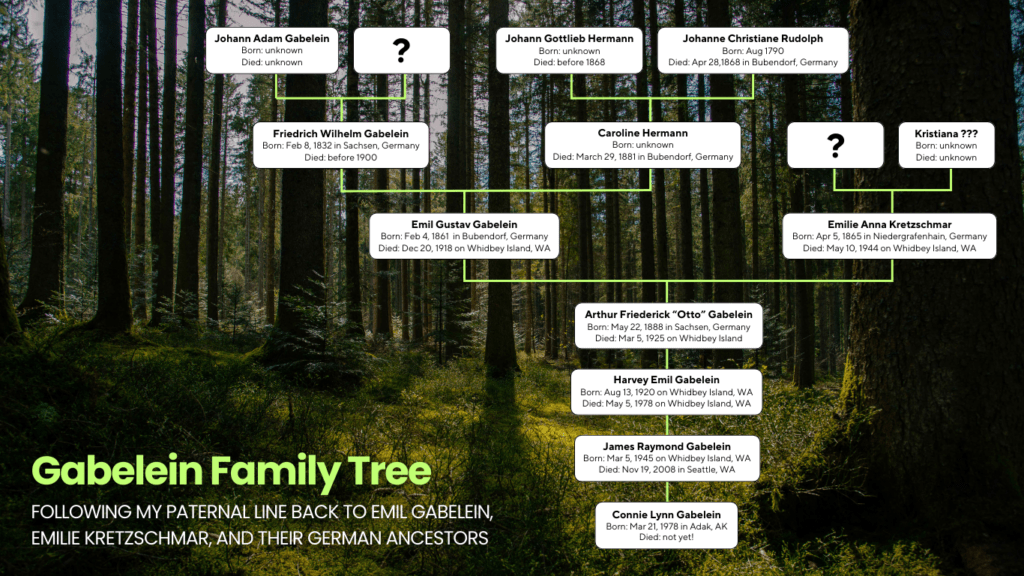
On the next frame, I used details from my research to build a simplified family tree which illustrated how I am related to Emil and Emilie. I also added the details about our ancestors in Germany which we recently found. I used the Black Forest stock image again as a background. I spent much longer than I would like to admit obsessing over this family tree. I struggled to decide how much detail to provide and how many relatives to include. In the end, I kept only my direct line to Emil and Emilie.
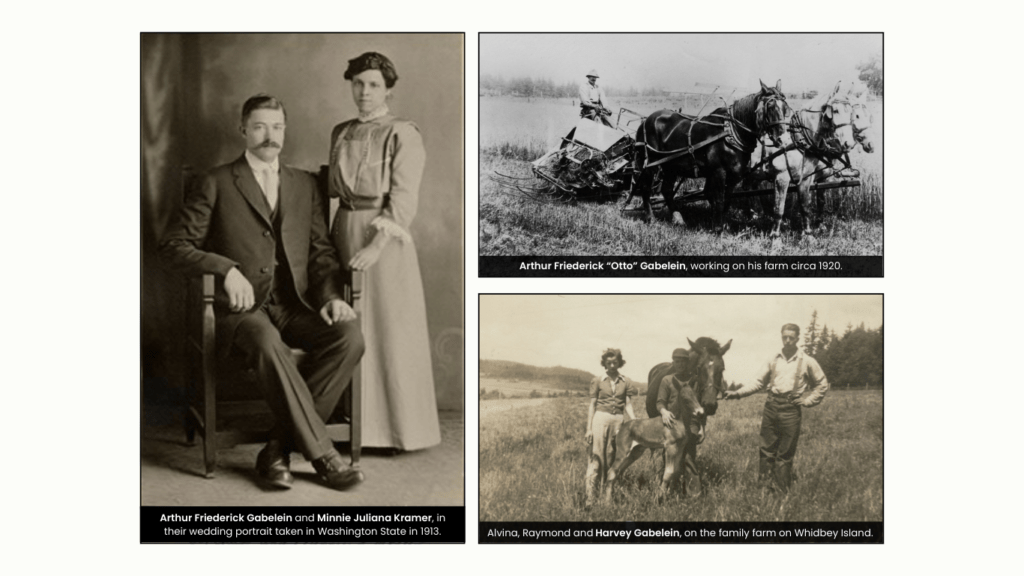
I wanted to highlight some images of my grandfather, Harvey Gabelein, and great-grandfather, Arthur Gabelein, who are mentioned in the previous frame. These are from my personal collection. Arthur was the son of Emil and Emilie.
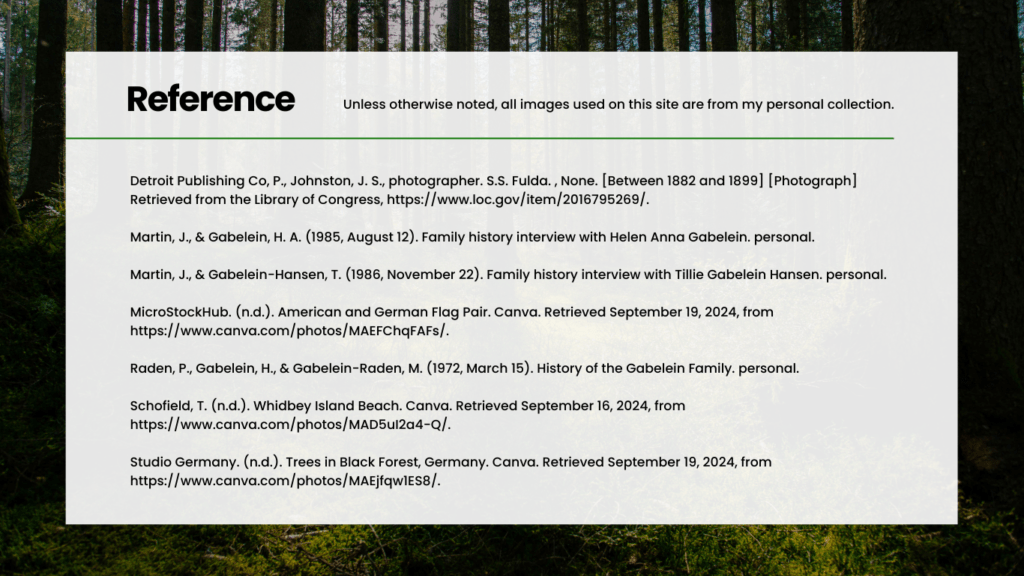
Most of the images used in my website were from my personal collections. I noted this on a reference list which cites interviews with Gabelein relatives and the histories compiled using them. Also cited are the stock photographs which I used.
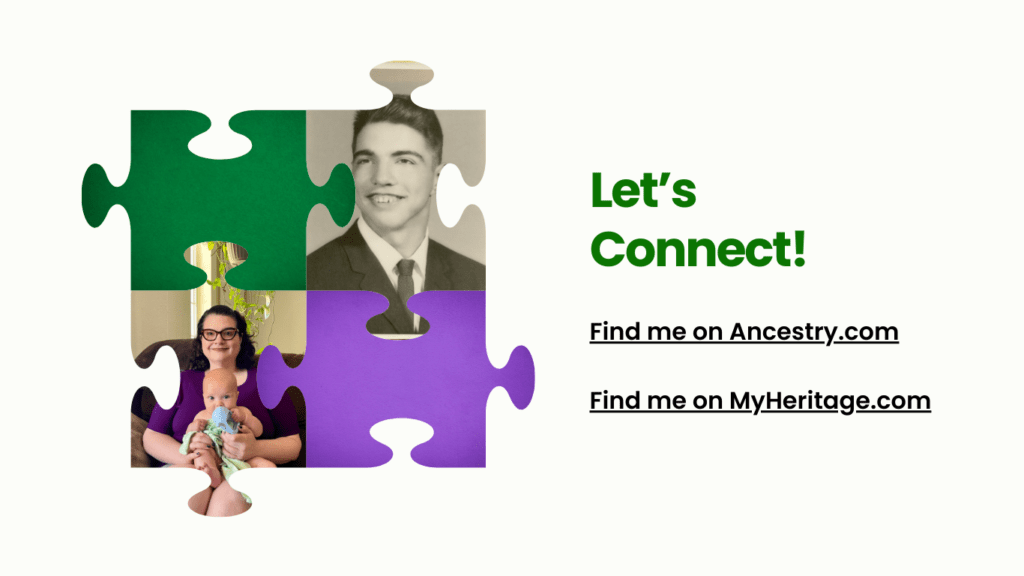
At the bottom of the page, I included one last frame with links to my profiles and family trees on Ancestry.com and MyHeritage.com. I added a photograph of me holding my baby grand-nephew, and one of my late father, James.
I really enjoyed this project and am looking forward to expanding it in the future to include an actual blog and a library of images and resources for family to access.
As mentioned above, I struggled to keep the project within scope and wasted a lot of time trying to make it perfect. This is not an unusual challenge for me, unfortunately. I tend to overthink projects and have to remind myself that “good enough” is often better than “perfect” if it means finishing on time.
Spreading the Word
To share this website with my friends and family members, I used Canva to create social media graphics for Facebook and Instagram, a blog post, and an email announcement.
Work cited
- Martin, J., & Gabelein, H. A. (1985, August 12). Family history interview with Helen Anna Gabelein. personal.
- Martin, J., & Gabelein-Hansen, T. (1986, November 22). Family history interview with Tillie Gabelein Hansen. personal.
- Raden, P., Gabelein, H., & Gabelein-Raden, M. (1972, March 15). History of the Gabelein Family. personal.
Unless listed below, all images used on this site are from my personal collection.
- Detroit Publishing Co, P., Johnston, J. S., photographer. S.S. Fulda. , None. [Between 1882 and 1899] [Photograph]
Retrieved from the Library of Congress, https://www.loc.gov/item/2016795269/. - MicroStockHub. (n.d.). American and German Flag Pair. Canva. Retrieved September 19, 2024, from
https://www.canva.com/photos/MAEFChqFAFs/. - Schofield, T. (n.d.). Whidbey Island Beach. Canva. Retrieved September 16, 2024, from
https://www.canva.com/photos/MAD5uI2a4-Q/. - Studio Germany. (n.d.). Trees in Black Forest, Germany. Canva. Retrieved September 19, 2024, from
https://www.canva.com/photos/MAEjfqw1ES8/.